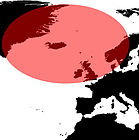Skeljaskrímsli
January 31, 2019
The name Skeljaskrímsli, which translates from Icelandic as shell monster, is a name used for a number of Icelandic seashore monstrous animals. Despite the differences in shape, two things link all these animals together:
-They are always observed dragging-hoping along the beach,
-They all have a hump on the back,
-They all possess a coat of shells that rattle as the creature moves.
Shell monsters have been sighted along the coasts of all the main regions of Iceland. In their book Meeting with Monsters, Hlidberg and Aegisson indicate that the skeljaskrímsli is a quadrupedal marine creature, bulky and powerfully built, its size is close to that of a winter’s old bull calf or a huge horse.
You can recognize this creature by its broad neck, a set of jaws and teeth of impressive dimensions, and its reddish eyes. If seen during the dusk or dawn, when light is less abundant, a phosphorescent glow may be observed coming from its mouth. Generally, unless it has lost a part of it in a fight, the skeljaskrímsli’s tail is long and armed with a lump at the end. Its short, strong legs end in circular feet armed with large claws. Suffice to say that anyone who encounters one of these surly brutes will be in for a bad time.
The skeljaskrímsli gets its name from the thick coat of shells (that at times may look like flaky scales of leathery skin) that covers its body. Fortunately, scraping against each other, these shells rattle as the creature moves, giving warning of its arrival, and a chance to escape, to unsuspecting passers-by. As the shell monster approaches, its powerful stench also becomes apparent. There is little good to say about this monstrous inhabitant of the Icelandic shores, for even its blood is toxic.
It is believed that the skeljaskrímslis live in the sea and haul themselves onto shore in the dark moonless nights of the northern winter. Often they can be seen before or after spells of bad weather and storms. Experience fishermen and those who live by the shore, know that this monsters are attracted to light sources, leaving deep gouges in farmhouse doors as testament to their nightly visits.

Most weapons are useless against a skeljaskrímsli’s formidable coat of armor. Ancient records tell of one farmer who battled a skeljaskrímsli, managing to keep it at bay for hours, until the monster tired and returned to the sea, Days later, the farmer was stricken with leprosy, for he was too close to the beast and probably inhaled some of its poisonous breath. The same record notes the case of another farmer managed, who wounded a skeljaskrímsli with a whale harpoon only to be splattered by some of its poisonous blood, dying in agony soon after.
To harm a skeljaskrímsli one must resort to alternative ammunition; a good musket loaded with silver buttons, grey willow catkins, or lamb droppings is the only ways to injure and kill this beast.
The Fjörulalli (to be found lurking along Fjords) is the best-known breed of the skeljaskrímsli. This subspecies has been reported to be smaller, about as big as a dog, and may or may not have a tail, with a head thta looks more like a small and rounded outgrowth from the body. Instead of being covered in shells, its coat is often made of lava fragments that scrape together as it moves. Unlike the larger shell-monsters, these smaller ones are usually harmless. They will, however, tear the udders off sheep, and pregnant women should avoid them lest they negatively affect their unborn babies.
References
Hlidberg, J. B. and Aegisson, S.; McQueen, F. J. M. and Kjartansson, R., trans. (2011) Meeting with Monsters. JPV utgafa, Reykjavik










